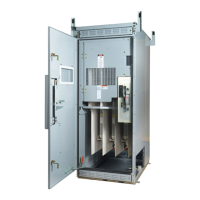21
Instructional Booklet IB02102006E
Effective May 2011
Type MVS (previously WLI)
metal-enclosed switchgear—
4.76 kV, 15.0 kV, 27.0 kV, and 38.0 kV
EATON CORPORATION www.eaton.com
Method B
For the following procedure, refer to Figure 29.
Step 1: Remove components fastened to the hinge end terminal pad
and retain for later re-installation.
Step 2: Remove the four bolts holding the stationary hinge parts
and the terminal pad to the insulator. Retain the terminal pad for
later re-installation with the new blade and hinge assembly.
Step 3: Remove the two bolts holding the break jaw to the upper
terminal. The jaw is now free.
Step 4: Replace the jaw, but only finger tighten its two mounting
bolts at this time.
Step 5: Install the new main blade assembly and terminal pad to the
insulator by installing the four bolts, but only finger tightening them
at this time.
Completing method A or B
Step 6: Align each blade following the instructions given
in “Closed-Open-Stop adjustment” section on page 18.
Step 7: Tighten the jaw mounting bolts.
Step 8: Method B only—tighten the blade and hinge assembly
mounting bolts.
Step 9: Method B only—install all previously retained components
fastened to the terminal pad.
Step 10: Align the flicker blade and arc chute following the
instructions given in “Closed-Open-Stop adjustment” section on
page 18.
Step 11: Check the flicker blade functioning following the
instructions given in “Main blade alignment” section on page 19.
If the functioning is satisfactory, connect the drive rod to main blade.
Step 12: Check the switch for adjustments following the
instructions given in sections “Override of the switch interlock
safety latch” through “Arc chute alignment.”
Step 13: Perform the pre-operation check detailed on this page.
Spring replacement
The main spring is a large compression spring along the inside of
the switch frame on the operating handle side (see Figure 30). For
several higher fault-close ratings, there is also an auxiliary spring
connected to the other end of the main shaft. If possible, close the
switch before removal of either spring.
Figure 30. Stored Energy Spring Replacement or Adjustment
Main spring replacement
Step 1: To disengage the main spring, remove the switch
mechanism cover (see Figure 23).
Step 2: Take a 5/16”–18 threaded rod 4.00 inches (101.6 mm) long
and screw it into the rear end of the spring rod.
Step 3: Make a spacer 3.00 inches (76.2 mm) long from a pipe or
tube with a 1.00 inch (25.4 mm) I.D. Put this over the 5/16” rod and
the main spring rod.
Step 4: Take a washer with an outside diameter larger than the
spacer and place it on the rod.
Step 5: Turn a 5/16”–18 nut onto the rod until it is hand-tight and
then center the spacer.
Step 6: Use a tool to tighten the nut until the tension
on the pin at the front of the spring rod is released.
Step 7: Remove one or both of the retaining E-rings holding the pin
in place and remove the pin. The spring assembly is now free from
the shaft.
Step 8: Loosen the 5/16–18 nut on the piece of all-thread rod to
relieve the tension.
Step 9: Remove the piece of all thread from the spring rod. The rod
and spring now may be removed.
To install the main spring assembly, reverse this procedure.
Auxiliary spring replacement
Step 1: To remove the auxiliary spring, put the switch in the
“Closed” position. While the compression spring is in its longest
condition, remove the elastic stop nut and bolt holding the spring
retaining rod to the small arm of the main shaft.
Step 2: Pull the spring rod away from its rear support. The spring is
now free of the rod.
To install the auxiliary spring, reverse the order of this procedure.
Shaft or bearing replacement
Step 1: Disengage the springs as instructed in “Closed-Open-Stop
adjustment” section on page 18.
Step 2: Remove the drive rods from the switch main shaft ears by
unbolting the connections.
Step 3: Remove the four bolts that hold the bearing support plates
on the end of the shaft opposite the operating mechanism.
Step 4: Slide the bearing support plates rearward, away from
the shaft.
Step 5: “Spring” the front of the unit slightly if the spring won’t
dislodge. The bearings can now be removed and replaced.
Step 6: To install the bearings or shaft, reverse the order of
this procedure.
Pre-operation check
After completing any maintenance, the alignment should be checked
(see page 17). After completing any alignment, the switch should
be put through at least three “Close-Open” operations to check for
proper performance.

